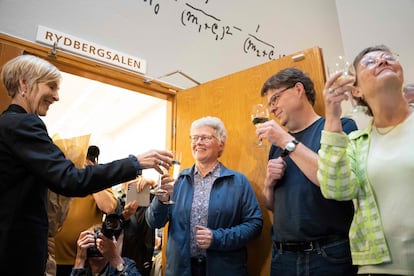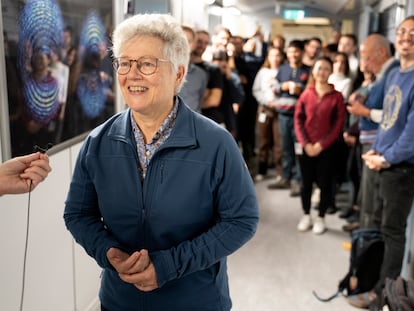Anne L’Huillier, Nobel Laureate in Physics: ‘People are mostly empty space’
The French scientist’s work unveiled the hidden world of electrons for humanity to explore

Professor Anne L’Huillier was teaching a physics class at Lund University in Sweden when the phone calls from an unknown number began. She finally answered during a break and learned that she was the winner of the 2023 Nobel Prize in Physics. The French scientist had just accomplished something that only four other women had achieved, starting in 1903 with Poland’s Marie Curie. Stunned, L’Huillier carried on teaching. “I think the students suspected something, but I didn’t say a word,” she said with a smile. The Swedish Academy had made her promise to keep the news a secret until the official announcement later in the day.
More than three decades ago, the French physicist conducted groundbreaking research that enabled the invention of ultrashort light pulses lasting a few attoseconds (trillionths of a second). Similar to how Eadweard Muybridge photographed a galloping horse in 1878, L’Huillier and her colleagues captured the motion of electrons using this ultra-fast flash. It represents the shortest timescale ever recorded by humans. Mind-blowing fact: there are more attoseconds in one second than there are seconds in the entire age of the universe.
L’Huillier says she’s exhausted from her two-day whirlwind when we caught up to her for this interview about her work that unveiled the hidden world of electrons for humanity to explore. All matter, including our bodies, are made up of atoms. Electrons act as the binding force, bringing atoms together to form molecules. The hydrogen atom, for example, has a nucleus around which a single electron orbits. To put this in perspective, if the atom were Earth-sized, the nucleus would only be around 200 meters (yards) in circumference. The rest of the space is set aside for the electron’s swift and unpredictable movements, happening in only trillionths of seconds.
Question. Electrons play a significant role in our lives beyond just everyday devices like computers and phones. We are made up of electrons — the human body contains approximately 23,000 quadrillion electrons, according to the Jefferson Laboratory in the United States.
Answer. I actually didn’t know that figure [laughs]. But we’re not just electrons — we’re made up of atoms and molecules. Of course, there are lots and lots of electrons, too.
Q. You were among the first to delve into the realm of electrons, the glue of all matter. Do you ever ponder existential questions when doing this kind of research?
A. The truth is that I don't ask myself many existential questions.
Q. What if someone asks you what we are? Are we just a bunch of atoms?
A. Well, that is an existential question. We are just atoms, yes.
Q. More than 99.9999% of the hydrogen atom — one of the most abundant elements in the human body — is empty space.
A. That’s right, atoms are mostly empty space. The nucleus is very, very small.
Q. It’s hard to imagine.
A. That's why physics is so fun.
Q. Do we have empty space in our bodies?
A. Yes, we are mostly empty space — I love that concept.

Q. The ultimate goal is to effectively manage the real-time movement of electrons within matter. Can we currently achieve this level of control over electrons?
A. A little bit. One of the objectives, for example, is to control the beginning of a chemical reaction.
Q. What could we accomplish by controlling electrons?
A. It would be extremely interesting to control processes such as photosynthesis [the process by which plants synthesize substances using sunlight as an energy source], but that’s not really my line of research.
Q. You said at the Nobel Prize ceremony that controlling photosynthesis would be like finding the Holy Grail.
A. Yes, controlling photosynthesis and other light-induced processes in large molecules would be a bit like finding the Holy Grail.
Q. Why do you say that? What would the world be like if we could control photosynthesis?
A. I don’t know, but if we could help solve some of the world’s problems, like climate change, that would be wonderful. But we’re still far away for achieving this and progress is very slow.
Q. American physicist Theodore Maiman invented the laser in 1960 without having an immediate application for it. At the time, he said it was “a solution looking for a problem.” You repeated that anecdote in June when you won the BBVA Foundation Frontiers Award here in Spain.
A. Yes, maybe attosecond pulses were also a solution in search of a problem. But 30 years later, we can now see some applications. The ability to measure the movement of electrons may lead to gaining some control over this movement, but we’re not there yet. There are some potential applications in the [electrical] semiconductor materials industry.
Q. Obviously, the laser was not invented to scan barcodes in supermarkets — it was the result of pure curiosity, just like your discoveries.
A. Yes — perfect. Basic research is very important, because you never know what applications will be found 30, 40 or 50 years later. We don’t know what the applications will be, but I’m sure they’re coming soon.
Q. The Swedish Academy said at the awards ceremony that one application of attosecond physics is to detect the characteristic signature of molecules in infrared light. This could be used to detect early-stage disease, such as lung cancer.
A. That’s what my colleague Ferenc Krausz [director of the Max Planck Institute for Quantum Optics in Germany] is doing. It’s still experimental research, so I don’t think it has already been applied to detecting cancer.
Q. The current record for the shortest light pulse ever measured is 43 attoseconds. What’s the limit?
A. Theoretically, there is no limit. But it’s very difficult to synchronize all the frequency components of this radiation, so I’m not sure it will be very easy to go below 50 attoseconds. But we’ll see.
Q. I read about some ideas for generating zeptosecond pulses [one thousandth of an attosecond]. What can we do with zeptosecond pulses?
A. I don’t really know. I suppose we would arrive at the timescale of nuclei, but I don’t know. I don’t want to say something stupid here.
Q. Ferenc Krausz has calculated that by using attosecond technology, we could multiply the current power of computers by a factor of 100,000. Do you agree?
A. Yes, I probably agree. The idea is to use an ultra-fast switch in electronic components, which has the potential to really speed up computer processing.
Q. So, controlling electrons in molecules could be compared to an ultra-fast switch that transforms an insulating material into a conductor of electricity. This kind of breakthrough could unlock materials with extraordinary properties.
A. I don't know, we'll see.
Q. During the Nobel ceremony, you said the award holds special significance due to few women who have won it. Out of 224 winners, only five have been women: Marie Curie, Maria Goeppert Mayer, Donna Strickland, Andrea Ghez and you. That’s barely 2%. You were on the Nobel Physics committee until 2015, so you know what happens behind the scenes. Why do you think they have only awarded the prize to five women since 1901?
A. Look at it another way. Donna Strickland won in 2018, Andrea Ghez in 2020, and now me — that’s three women in five years. Not bad. What I want to say is, things are changing. A century ago, women didn’t do research. There still needs to be more women, but things are definitely changing.
Q. You don’t think there’s a problem in how the Nobel committee makes decisions?
A. They were probably two factors: the decision-making mechanisms and the composition of research groups. Society was very different 100 years ago — women raised children. I hope this is changing and that can help a little bit with this.
Q. Have you encountered sexism during your career?
A. I’m a woman and have probably suffered from some unconscious bias. But I have also benefited from having more visibility and receiving the help of other women. There have been good and bad things. I can’t say I’ve had it harder, because I don’t know. It has just been different for me. I certainly don’t want to say I’ve suffered from sexism during my career — this isn’t true.
Q. Physicist Joseph John Thompson discovered the electron in 1897. Now, a century later, you’re able to study its motion. What do you predict will happen in the next century?
A. I have no idea — who knows?
Sign up for our weekly newsletter to get more English-language news coverage from EL PAÍS USA Edition
Tu suscripción se está usando en otro dispositivo
¿Quieres añadir otro usuario a tu suscripción?
Si continúas leyendo en este dispositivo, no se podrá leer en el otro.
FlechaTu suscripción se está usando en otro dispositivo y solo puedes acceder a EL PAÍS desde un dispositivo a la vez.
Si quieres compartir tu cuenta, cambia tu suscripción a la modalidad Premium, así podrás añadir otro usuario. Cada uno accederá con su propia cuenta de email, lo que os permitirá personalizar vuestra experiencia en EL PAÍS.
¿Tienes una suscripción de empresa? Accede aquí para contratar más cuentas.
En el caso de no saber quién está usando tu cuenta, te recomendamos cambiar tu contraseña aquí.
Si decides continuar compartiendo tu cuenta, este mensaje se mostrará en tu dispositivo y en el de la otra persona que está usando tu cuenta de forma indefinida, afectando a tu experiencia de lectura. Puedes consultar aquí los términos y condiciones de la suscripción digital.
More information
Últimas noticias
A floating school teaches children how to save Lake Atitlán
Pablo Escobar’s hippos: A serious environmental problem, 40 years on
From Andorra to Gibraltar, a black market for Ozempic exploits its success: ‘They’re the most sought-after products in the world’
The brief rise and retreat of Generation Z in Mexico
Most viewed
- Why we lost the habit of sleeping in two segments and how that changed our sense of time
- Charles Dubouloz, mountaineering star, retires at 36 with a farewell tour inspired by Walter Bonatti
- Venezuela faces its most tense Christmas yet
- CBS in crisis after pulling a report on Trump’s deportations to El Salvador (which later leaked online)
- Bukele clan fumes over investigation exposing their new wealth











































